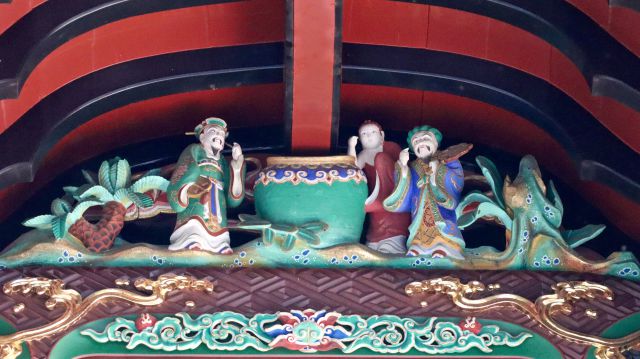If you’re in Kanto area you should go visit Kangiin Shôdendô in Kumagaya Saitama.

It’s designated as a national treasure and located in very close to Tokyo, 1h30m from Ikebukuro, 1h50m from Shinjuku by train and bus. Nowadays you can get directions very easily by Google Maps. You shouldn’t miss it when you are in Kanto area Japan.

The main hall enshrines Shoden (Kangi-ten), the deity of joy, conjugal harmony, and longevity, who is the Buddhist representation of the Hindu god Ganesha.
Establishment in 1179
Started to rebuild in 1735
Completed in 1742
Chief carver: Ishihara Gimpachiro from Joshu Hanawa village
Worship Hall
Under the pent roof there are carvings of several people and a green dragon as a guardian of the temple.

Those people express KINKI-SHOGA that is one of the most typical themes of Japanese art, the four elegant pastimes as music, the game of GO, calligraphy and painting.

Inner Sanctuary
Visitors can walk around the back of the main hall to view the carvings more closely with a small amount of fee.

The left side of the main hall

Juroujin on the big panel of the main hall.

Juroujin is the god of longevity and a member of the Seven Lucky Gods. He is often put with a deer and crane.

On the eave there is a carving of The Three Vinegar Tasters, called Sansei-Kyusan in Japanese (三聖吸酸 lit. three sages suck acid).

Three men, Confucius, Buddha and Laozi are tasting vinegar. It tastes sour no matter what their individual beliefs are. This suggests that there is only one truth.
Above the stairs there is a carving of a hawk capturing a monkey. The guide book I bought here says that the hawk symbolizes Buddha and is helping the monkeys that symbolize human.

This is also one of the most poplar motifs of Japanese art. Normally it’s thought that it expresses “the survival of the fittest”.
The back of the main hall

There is a carving of Sima Guang on the eave. Sima Guang was a Chinese historian, politician and writer.

When young Sima Guang was playing with his mates one of them had fallen into a sumptuous vat with full of water. As other children scattered in panic, Sima Guang calmly picked up a rock and smashed a hole in the base of the pot. Water leaked out, and his friend was saved from drowning.
There are three big panels on the back of the main hall and this is the center one.

Hotei and Ebisu playing game GO and Daikoku watching it. They are also counted among the Seven Lucky Gods.
The right side of the main hall
There are big panels on the wall.

On the one of them there are members of the Seven Lucky Gods, Kissho-ten and Benzai-ten playing backgammon and Bishamon-ten watching it.

Red Oni that is called Amanojaku beckoning Queen Mother of the West (an ancient Chinese goddess who controls the live and death) looks very humorous.
Look at the pattern on the clothings.

Many layers of paints and gold leaf made it look 3 dimension. I can’t believe this is exposed to rain! This building is a national treasure!
They say those panels were referred to the book “Ehon-Kojidan by Tachibana Morikuni from the Kano school.

From Ehon-Kojidan by Tachibana Morikuni
On the eave there is a carving of Shojo that are creatures from Japanese folklore. They often depicted as a sea spirit with red hair and a fondness for sake.

All three eaves are related to vat.
HORISHI, carvers
Ishikawa Gimpachiro and Sekiguchi Bunjiro and many master craftsmen were involved in this project.
It’s not sure which one is whose work. But they know who carved just these two carvings of Houou (asian phoenix).
Houou on the left side, carved by Ozawa Goemon Tsunenobu.

Houou on the right side, carved by Goto Shigeemon/Moemon Masatsuna.

various carvings
Kaminari sama aka Raijin, god of thunder

Dembo sama aka Senko NyanNyan, Raijin’s wife

Fujin, god of wind

KARAKO
Karako (唐子) is a Japanese term used in art with the depiction of Chinese children playing.

The literal translation means “Tang children”.

They symbolise the innocence and joy of childhood.



Tattooist Ryugen
Roppongi Tokyo